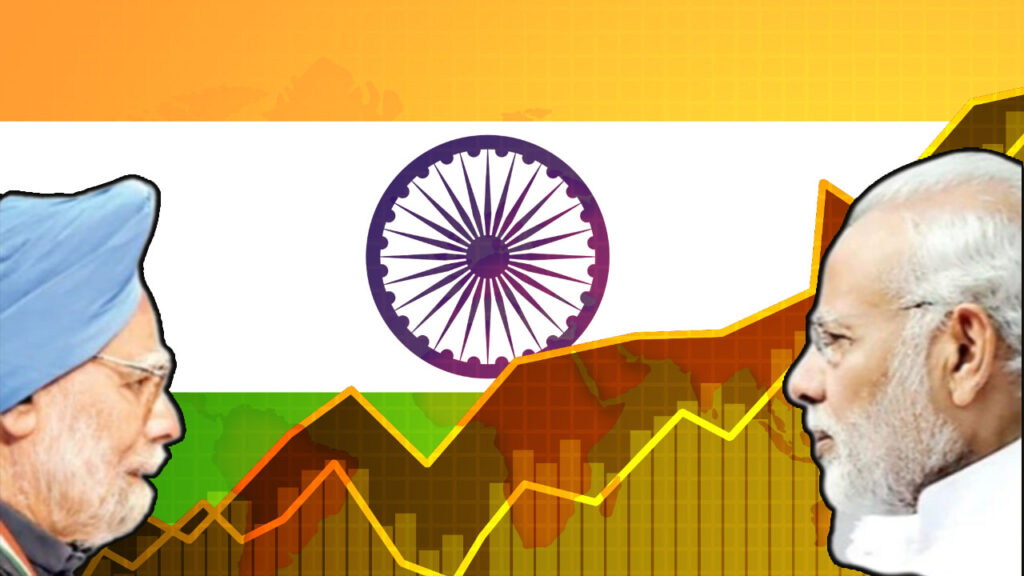
- Manmohan Singh’s reforms had a significant impact on Indian society, promoting economic growth, consumer choice, and higher living standards.
- However, his tenure as Prime Minister was marred by significant challenges with allegations of institutionalized corruption and policy paralysis in various sectors.
- On the other hand, #NamoNomics has been a comprehensive economic model that has brought about dramatic changes in India’s economic environment since 2014.
- The forward-thinking approach of #NamoNomics addresses long-standing difficulties, eliminates inefficiencies, and promotes long-term growth.
Significant economic policy decisions that opened a new chapter in the development of Bharat were made in the years 1991 and 2014. The era that began in 2014 is now widely known as #NAMONomics, and the reforms that were started in 1991 were known as #Manmohannomics. #Manmohannomics and #NAMONomics are two separate economic philosophies that have left an indelible imprint on India’s economic destiny. In this comparison, we look at the key concepts and implications of two opposing visions for the country’s growth.
Manmohan Singh, India’s Prime Minister for two terms and Finance Minister from 1991 to 1996, oversaw dramatic economic changes that addressed the country’s grave balance of payments issue. India had a significant economic crisis with depleting foreign exchange reserves during his stint as Finance Minister. In order to receive a loan from the International Monetary Fund (IMF), Singh pledged a share of India’s gold holdings, a historically momentous action. This step, together with the removal of the constraining License/Permit Raj, stressed fiscal restraint and economic stability, resulting in increased growth, job opportunities, and a growing middle class.
Further, Singh’s push for liberalization and globalization drew foreign investment, further strengthening India’s integration into the global economy. These reforms had a significant impact on Indian society, promoting economic growth, consumer choice, and higher living standards. Singh’s role in transforming India’s economic landscape, both as Prime Minister and as Finance Minister, remains a watershed moment in the country’s history, and his reforms were dubbed #Manmohannomics.
However, his tenure as Prime Minister was marred by significant challenges, including allegations of institutionalized corruption. During his leadership, there were concerns about crony capitalism influencing the banking sector, resulting in questionable loans to select industrialists. Additionally, India witnessed high-profile corruption scandals, including the 2G Scam, CWG Scam, Thoium Scam, and Capital Goods Scam. These scandals raised serious concerns about transparency and accountability in the government. Economic growth during this period appeared skewed, favouring a select few, while income inequality persisted. India’s inclusion in the “Fragile Five” economies during his tenure reflected the economic challenges the country faced. Despite Manmohan Singh’s initial commendable economic reforms, his leadership faced criticism for failing to adequately address corruption and ensure equitable growth during his two terms as Prime Minister.
On the other hand, Prime Minister Narendra Modi’s #NamoNomics has been a comprehensive economic model that has brought about dramatic changes in India’s economic environment since 2014. This forward-thinking approach addresses long-standing difficulties, eliminates inefficiencies, and promotes long-term growth.
The following are key pillars of #NamoNomics:
Demonetization: A bold move to curb black money and promote digital transactions, fostering financial transparency.
Goods and Services Tax (GST): The implementation of GST streamlined taxation, simplifying the complex tax structure and promoting ease of doing business.
JAM Trinity: Jan Dhan Yojana (financial inclusion), Aadhar (digital identity), and Mobile Connectivity (easy access to financial services) have boosted financial inclusion.
Insolvency and Bankruptcy Code (IBC): A game-changer in resolving corporate insolvencies, ensuring a more efficient business environment.
Social Welfare Initiatives: Initiatives like Ujjwala (clean cooking fuel) and Ayushman Bharat Scheme (healthcare) prioritize the welfare of citizens.
International Collaboration: India’s active participation in forums like the International Solar Alliance and the development of trading sea routes strengthen global partnerships.
Make In India: Fostering domestic manufacturing and self-reliance, attracting investments and creating jobs.
Production-Linked Incentive (PLI) Scheme: Encouraging investments in key sectors to boost production and exports.
Space Exploration and Defense Partnerships: Advancing India’s capabilities in space technology and bolstering defence ties.
Digital Payments (UPI): Promoting a cashless economy, enhancing financial inclusion, and enabling seamless transactions.
Currency Settlement in INR: Simplifying international trade by settling goods and services in Indian Rupees.
Semiconductor Initiatives: Boosting semiconductor manufacturing to reduce dependency on imports.
GIFT City: The Gujarat International Finance Tec-City promotes international finance and trade.
Infrastructure Development: Extensive investments in roads, railways, airports, waterways, and renewable energy.
Environmental Initiatives: Promoting EVs, hydrogen fuel, ethanol, and renewable energy sources for a sustainable future.
NamoNomics has not only transformed India’s economic landscape but has also made India a formidable force on the global stage. Under Prime Minister Modi’s leadership, India has achieved significant international milestones:
G20 Presidency: India, under Modi’s leadership, successfully included the African Union in the G20, strengthening ties with the African continent.
Indo-Middle East European Trade Corridor: A strategic initiative fostering trade connectivity between India, the Middle East, and Europe.
Black Sea Grain Initiative: Agreement to restore this vital trade initiative, ensuring food security and economic stability.
Debt Relief for Poor Countries: Efforts to recast the debt of impoverished nations, offering them a fresh start.
World Biofuel Alliances: Collaborations to promote sustainable and renewable biofuels on a global scale.
Sharing Digital Public India Infrastructure with the world and acknowledged by the World Bank to achieve financial inclusion covering 80% of the population in six years.
NamoNomics stands as a testament to visionary leadership, conviction, and the willingness to make tough decisions for the greater good. It is shaping India’s future and elevating the nation’s standing in the world.
In conclusion, Manmohannomics laid the groundwork for critical reforms, but it battled with difficulties like as corruption and unequal growth. NAMONomics, on the other hand, has prioritized reforms, openness, and global integration while also tackling crucial social welfare and environmental concerns under Prime Minister Modi’s leadership. This contrast reflects the shifting economic strategies and priorities that have defined the Indian economy over time.
(The views expressed are the author’s own)
